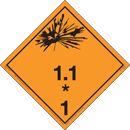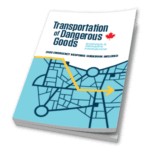Class 1 Explosives: Divisions, Compatibility Groups, and Segregation
Are Class 1 Explosives a hazardous material classification used in the transportation of various explosive substances? Certainly! The classification is further divided into six divisions, each with specific characteristics and safety requirements. Additionally, there are compatibility groups that indicate how different explosives should be stored and transported in relation to each other.
Division of Class 1 Explosives:
- Division 1.1 – Mass Detonation Explosives:
- These explosives pose a mass explosion hazard. They are extremely dangerous and can cause a widespread impact, such as TNT, dynamite, and nitroglycerine.
- Division 1.2 – Projection Hazard:
- Explosives in this division have a projection hazard but not a mass explosion hazard. They can propel fragments and are still very dangerous. Examples include some types of fireworks.
- Division 1.3 – Fire Hazard and Minor Blast or Projection Hazard:
- Explosives in this division pose a fire hazard and a minor blast or projection hazard. They can cause fires, but the blast or projection is not significant. Ammunition falls into this division.
- Division 1.4 – Minor Explosion Hazard:
- Explosives in this division present a minor explosion hazard. They are unlikely to cause a mass explosion and have minimal risk during transportation. Examples include safety ammunition.
- Division 1.5 – Very Insensitive Explosives:
- These explosives have a mass explosion hazard but are so insensitive that there is very little probability of accidental initiation or propagation. For example, ammonium picrate.
- Division 1.6 – Extremely Insensitive Detonating Substances:
- These explosives do not have a mass explosion hazard. They are so insensitive that there is virtually no probability of accidental initiation. Examples include certain explosive substances in a wet state.
Compatibility Groups:
In addition to divisions, Class 1 Explosives have compatibility groups, denoted by a letter (A to S), indicating how different explosives should be stored and transported together to reduce the risk of accidental reactions. For instance:
- Compatibility Group A: Substances that demonstrate a mass explosion hazard (Division 1.1).
- Compatibility Group B: Substances that demonstrate a projection hazard but not a mass explosion hazard (Division 1.2).
- Compatibility Group C: Substances that demonstrate a fire hazard and either a minor blast or projection hazard or both, but not a mass explosion hazard (Division 1.3).
Segregation:
Segregation refers to the proper separation of hazardous materials during transportation to prevent potentially dangerous reactions. For Class 1 Explosives, segregation is essential to reduce the risk of accidental detonation or ignition. The segregation rules are based on the compatibility groups and the nature of the explosives.
For example, certain explosives shouldn’t be stored or transported together due to their potential for reaction or enhanced sensitivity. Proper segregation is crucial to maintain transportation safety and prevent accidents involving Class 1 Explosives.
Always refer to the specific regulations and guidelines provided by the relevant transportation authority, such as the Department of Transportation (DOT) in the United States or Transport Canada, for precise and up-to-date information on segregation and division of Class 1 Explosives.
ICC is passionate about keeping us all safe when handling, storing, manufacturing, or transporting dangerous goods. Our team can help your business stay compliant and informed through our resources and products. Contact us to learn more about the ICC difference.
Stay up to date and sign up for our newsletter!
We have all the products, services and training you need to ensure your staff is properly trained and informed.
 Hazard Class 1 Hazard Class 1Explosive Placards |
 Canadian TDG Canadian TDGPublications |
 Shipping Dangerous Shipping DangerousGoods by Ground |






